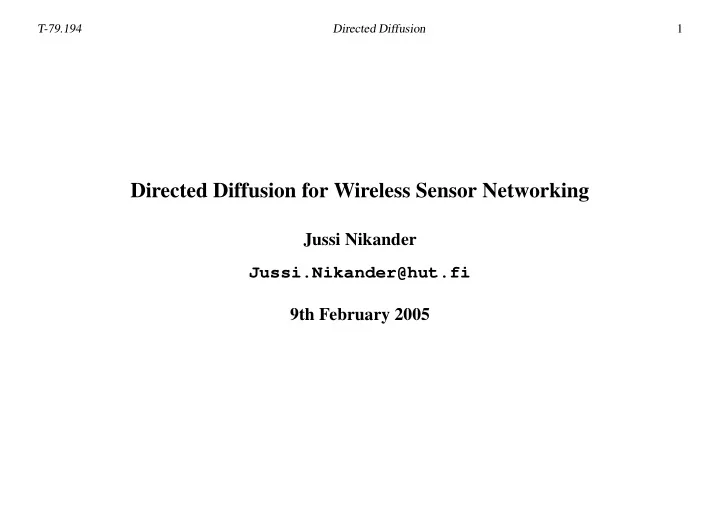

T-79.194 Directed Diffusion 1 Directed Diffusion for Wireless Sensor Networking Jussi Nikander Jussi.Nikander@hut.fi 9th February 2005
� � � T-79.194 Directed Diffusion 2 Contents Directed Diffusion method Evaluation – Mathematical analysis – Simulations Conclusion
� � � � � T-79.194 Directed Diffusion 3 Directed Diffusion Protocol for distributed microsensing , an activity where several cheap, low–powered nodes coordinate to achieve a sensing task Designed for robustness, scaling and energy efficiency Requires only localised interaction between nodes Data–centric approach: communication based named data, not named nodes four main features: Interests , Gradients , Data and Reinforcement
� � � T-79.194 Directed Diffusion 4 Interests and Data Naming Interest is a named task description. – Defines the data (sensor events) the originator is interested in – Inserted to the network at some (possibly arbitrary) node called a sink – Interests are diffused through the network to all (relevant) nodes Naming distinguishes between different tasks – Name can, for example, be a number of name–value pairs Exploratory interests used to find out if there are any interesting phenomena
� � � � � T-79.194 Directed Diffusion 5 Interest Propagation and Storage Each node maintains a cache of active interests an interest is a soft state, the sink must periodically refresh it Each node only knows the previous hop from which it received the interest, not the sink Each interest has one or more gradients associated with it Upon receiving an interest message, a node updates it cache, and may resend the message to (some subset of) its neighbour nodes.
� � � T-79.194 Directed Diffusion 6 Gradients Each interest entry has at least one gradient that tells where to forward data associated with the interest . An interest may have several gradients associated with it A gradient contains – the node where to forward data (the previous hop where the interest was received from) – Data rate, which tells how often data events should be forwarded – duration, which tells how long data should be forwarded
� � � � T-79.194 Directed Diffusion 7 Data Propagation and Path Reinforcement Nodes sensing events queried by an interest send data messages to the network Data is forwarded according to the gradients associated with the interest Intermediate nodes may aggregate data in some cases When a sink starts to received data it can reinforce one or more neighbours – Reinforcement is done to draw in more data – Done by sending new interests with larger data rates – Reinforcements create paths through which data flows at high speed – Also possible to negatively reinforce unwanted paths
� � T-79.194 Directed Diffusion 8 Evaluation In evaluated situations several source nodes send data messages to several sinks . Directed Diffusion compared to two idealised schemes – Flooding , where each data message is sent to every node in the network. Watermark comparison: useful scheme should be at least as good. – Omniscient Multicast , where each message is sent to the sinks using shortest path multicast trees. Represent best case for IP–networks.
✁ ✂ � ✄ ✂ ✂ ✄ � ✁ ✂ � ✁ � � � � T-79.194 Directed Diffusion 9 Mathematical Analysis Schemes evaluated in a grid–shaped idealised network with N nodes. Results, when n is the number of sources, each of which sent one data message and m number of sinks: Total delivery costs are compared – Flooding O nN – Omniscient Multicast O n N , when m N – Directed Diffusion O n N , when m N Directed Diffusion more efficient than Omniscient Multicast despite similar results
� � � � � T-79.194 Directed Diffusion 10 Simulation Environment Five sizes of networks, between 50 and 250 nodes Average node density constant in all simulations Five source and five sink nodes Low idle–time power dissipation Metrics used – Average dissipated energy – Average delay – Distinct–event delivery ratio
� � � � T-79.194 Directed Diffusion 11 Simulated cases Comparative evaluation of different schemes Impact of temporary node losses on Directed Diffusion Impact of Data aggregation and Negative Reinforcement Impact of high idle time power consumption
� � � � T-79.194 Directed Diffusion 12 Simulation results Directed Diffusion has lowest average dissipated energy Can handle node failures Data aggregation and negative reinforcement enhance performance considerably Differences in power consumption disappear if idle–time power consumption is high
� � � T-79.194 Directed Diffusion 13 Conclusion Implementation for several platforms mentioned The question of node mobility? Questions?
Recommend
More recommend